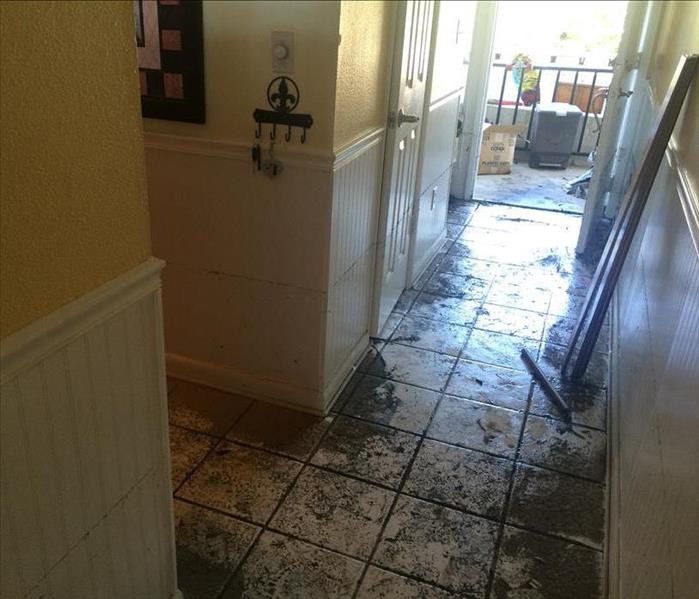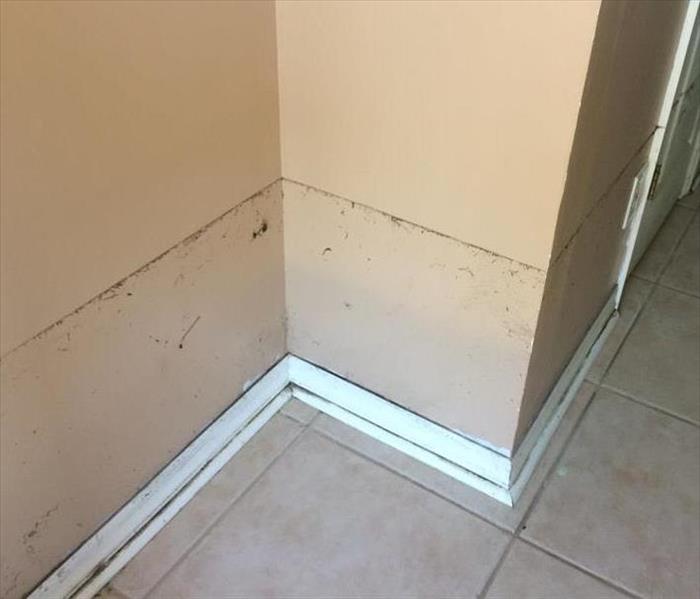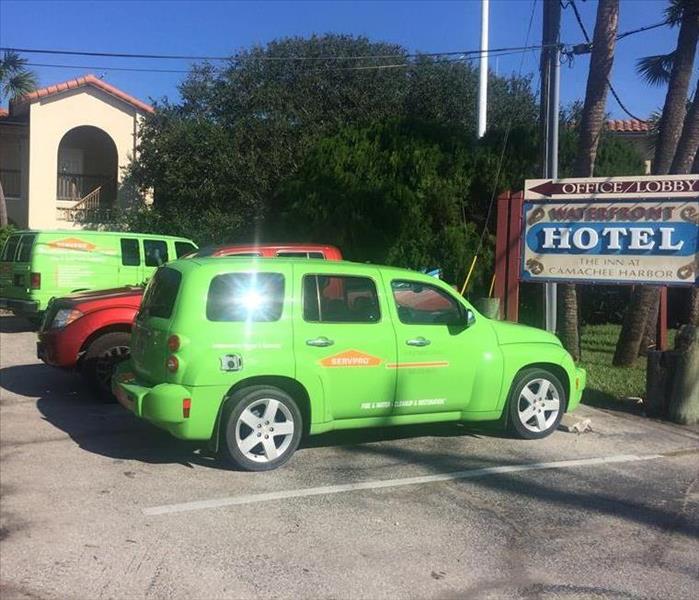Recent Storm Damage Posts
What should you do after a storm?
5/24/2023 (Permalink)
Returning to our normal routine after storm damage can be absolutely so tiring and without a doubt stressful. Storms are a naturally occurring phenomenon that we should never take for granted no matter how strong the storm signal. Storms come with heavy rain causing a flood that can destroy our establishments and homes. Strong wind, lightning, and heavy rain are common when a storm is coming or is in the area.
Here are a few safety tips on what to do after the storm.
1. After the storm, assess your property and the structural damage it has after the storm and take numerous photos if possible.
2. Secure your home for further damage, cover the broken windows but don’t try to fix it yourself until an authorized person has checked and secured the home.
3. Stay away from the open wire and hanging electric wires. Be careful turning on your generators
We Specialize in Flood Cleanup
2/3/2022 (Permalink)
SERVPRO of Putnam County sees flooding often since we have miles of local properties on the St. Johns River. A home can flood at any time due to heavy rainfall in a short period of time or when storms come in during high tide. However, flooding could also occur due to the following events:
- A blocked or failed sewer lateral pipe
- Heavy rain causes surface water to pool around your home
- Storm sewer backup
- Sanitary sewer backup
- Foundation drainage failure
- Water supply-line break or hot-water tank failure
- And many more
If flood water is not handled quickly and properly, it can cause health effects and cause severe damage to your home’s structure. Remember, the longer you wait, the worse the problem will get.
Let our trained, professional crews handle the situation safely and correctly.
Have questions about flooding? Call us today. We’re ready to help (386) 328-8660.
Hurricane Evacuation Plan
2/2/2022 (Permalink)
Do you have a hurricane evacuation plan? Hurricane season begins June 1st and lasts until November, and if you live near a coastal town, hurricane preparedness is vital for keeping your family safe. Even if you do not think you’ll want to evacuate, there may come a time when officials make it mandatory. A Florida hurricane can quickly become dangerous and may not leave you much time. Planning will help make the experience much easier and more comfortable.
- Keep track of the local weather. Sign up for alerts from the National Weather Service so that you will know if a hurricane watch or warning is in effect for your area.
- Decide on a destination. Where will you wait out the storm? You can choose to stay with out-of-town friends or family, rent a hotel room, or stay at a local shelter, but it’s important to know where you’re going and map it out in advance. If you have pets, make sure to include them in your plans. If it’s not safe for you to be home it’s not safe for your pets. Choose a place to stay that accepts pets or make other arrangements for your furry family members.
- Pick your route and plan for detours. Your local government will offer suggested routes to make it easier to get to safety, but it’s smart to know at least three ways to get to your destination. You never know if a road is going to be blocked by flooding, a washed-out bridge, or downed trees. Throughout hurricane season, keep your gas tank full. That way you’ll be sure you have enough gas to get you where you’re going even if you run into trouble. Additionally, it will keep you out of the long lines that inevitably form at gas stations during natural disasters.
- Be thorough with emergency supplies. Keep an emergency kit in the trunk of your car with fresh water, non-perishable snacks, blankets, a phone charger, road maps, garbage bags, toilet paper, paper towels, a gas can, jumper cables, and a towline. Each family member should have a bag with changes of clothes and a copy of the evacuation plan. Additionally, have a hurricane preparedness kit that’s easy to grab, like a backpack, containing:
- Copies of important documents
- Flashlights and batteries
- Battery-powered radio
- Medications
- Cash
- Extra keys for your house and car
- Know who to call. Make plans with your family members in case you are separated. Decide upon a meeting spot or two where you will reconnect, and pick an out-of-state friend or family member to call with updates.
If your Putnam County home is damaged in a hurricane or tropical storm, call SERVPRO of Putnam County Our highly-trained restoration technicians have the experience and equipment to restore Putnam County home to its pre-storm condition. A trusted leader in the water restoration industry, we have served our community for more than 25 years. Call us at (386) 328-8660.
Hurricane Preparedness
2/2/2022 (Permalink)
 If you suffer any storm damage, let the professionals at SERVPRO of Putnam County take care of it for you.
If you suffer any storm damage, let the professionals at SERVPRO of Putnam County take care of it for you.
Preparing Your Home for a Hurricane
Hurricane season begins June 1st and lasts until November, and if you live in a coastal town, hurricane preparedness is vital for keeping your home and family safe. Will you be ready if there is a hurricane? Here are some steps for preparing your home.
- Make a storm kit. This kit should have supplies to get your family through 48 hours of bad conditions, with no electricity, water, or other basic services. It should have three days’ worth of water and a two day supply of food, as well other important provisions. Ready.gov offers a list of supplies here.
- Gas up your generator. If you have a 5,500 watt generator, it will require about five gallons of gasoline to run for eight hours. Fill up some gas cans so that you’ll be prepared if emergency conditions last for several days.
- Bring things inside from outside. Lawn furniture, toys, garden tools, and anything else that could be blown away in the storm should come inside. Anything you can’t bring inside should be anchored.
- Know the location of your water, gas, and electricity shut offs. After a disaster, it’s recommended that you shut off your water until you know it’s safe to drink. If your home experiences flooding or severe water damage, we recommend shutting off your electricity as well. Don’t turn off your gas until local officials tell you to do so.
- Get your windows, doors, and garage doors ready for the storm. Ideally, you’ve installed storm shutters on your windows, in which case you’ll just need to brace your doors and secure your garage door. If your windows don’t have storm shutters, plywood or other hard materials can be temporarily affixed to the exterior for protection from wind and flying objects.
- Turn down your refrigerator and freezer. Lowering your refrigerator and freezer to their lowest setting cools the food so that it will stay cold for a while if the power goes out.
- If the power goes out, unplug your electrical appliances. This will keep them from being damaged if there’s a power surge when the electricity comes back on.
- Get your insurance documents together. Your home insurance documents and other important papers should go into a waterproof bag to be kept inside your storm kit. You will need them readily available should your experience damage because they’ll make things easier in the aftermath of the storm.
- Have a plan for your pets. Your pets should be microchipped, and you should have a picture of each pet handy in case they get lost in the storm. Because emergency shelters do not always accept pets, make a plan for where they will go in an emergency if you are unable to bring them with you.
Sometimes homes sustain damage, even if you’re as prepared as possible for the storm. If your Putnam County area home is damaged in a hurricane or tropical storm, call SERVPRO of Putnam County. Our highly-trained restoration technicians have the experience and equipment to restore your home to like new, "Like it never even happened." A trusted leader in the water restoration industry, we’ve served our community for more than 25 years. Call us at (386) 328-8660.
Be Prepared for Severe Weather
6/22/2021 (Permalink)
Be Prepared for Thunderstorms and Severe Weather
- Learn about your local community's emergency warning system for severe thunderstorms
- Discuss thunderstorm safety and lightning safety with all members of your household
- Pick a safe place in your home for household members to gather during a thunderstorm. This should be away form windows, skylights, and glass doors that could be broken by strong winds or hail.
- Make a list of items to bring inside in the event of a severe thunderstorm
- Make trees and shrubbery more wind resistant by keeping them trimmed and removing damaged branches
- Protect your animals by ensuring that any outside buildings that house them are protected in the same way as your home
- Consult your local fire department if you are considering installing lightning rods
- Get trained in first aid and learn how to respond to emergencies
- Put together an emergency preparedness kit that includes the following:
- Water- one gallon per person, per day
- Food- non-perishable, easy to prepare
- Flashlight
- Battery powered or hand crank radio
- Extra batteries
- First aid kit
- Medications (7day supply) and medical items
- Multi purpose tool
- Sanitation & personal hygiene items
- Copies of personal documents
- Cell phone with charger
- Family & emergency contact information
Generator Safety
9/6/2019 (Permalink)
Valuable Tools
After a hurricane, generators are a precious commodity. From running just a few appliances to being able to run your entire home, generators come in all shapes and sizes. With all the benefits of having a generator they also come with some dangers.
Carbon Monoxide
From 2005 to 2017 more than 900 people died from carbon monoxide poisoning from generators. The carbon monoxide produced from a generator can cause death in as little as five minutes! Never run your generator inside your home or garage. Place your generator at least 20 feet from your home.
Refueling
Always shut down and allow your generator to cool down before refueling. Gasoline spilled on hot engine parts can ignite. Allowing the engine to cool also reduces the chances of getting burns when coming in contact with engine parts.
Gasoline Storage
Be sure to store your extra gasoline only in approved containers. Place your gas cans in cool, well ventilated areas.
Back-feeding
Never attempt to back-feed your home with your generator. Not only can this damage your electrical appliances, but it also puts utility workers at risk of being electrocuted. Have a transfer switch installed by an electrician.
Patience
While some generators can supply enough electricity to power your entire home, chances are that you have a much smaller one. That means you are probably having to get by without air conditioning. Just be patient, and the utility crews will have power restored whenever it is safe for them to do so.
Hurricane Irma Cleanup
2/13/2018 (Permalink)
Calls for Help Started Early
When Hurricane Irma came through we started getting calls for cleanup almost as soon as the wind and rain started. Our list grew and it grew quick!
No Electricity
Once Irma moved out and we were finally able to make it out on the roads we found out that our office had no electricity. With no phones, internet, or electricity that slowed our response some, but we moved as quick as we could.
Different from Hurricane Matthew
Irma's damage was completely different from Matthew. Most of the damage from Matthew was from flood waters caused by tidal surge. Irma's damage was mostly from wind driven rains.
Irma Cleanup Continues
We worked on the bulk Hurricane Irma's damage from the time it moved out in September until the beginning of December. We are still getting some call form customers about storm damage, but they are people who didn't realize they had damage and they now have a mold problem.
Here to Help
Here at SERVPRO of Putnam County it is our privilege to help out in our community and surrounding communities whenever storms roll through! We will always be here to make it, "Like it never even happened."
Hurricane Matthew Recovery
12/29/2016 (Permalink)
 This home was completely flooded from the tidal surge caused by Hurricane Matthew. As a result the home had to be completely gutted.
This home was completely flooded from the tidal surge caused by Hurricane Matthew. As a result the home had to be completely gutted.
Helping in our hometown and surrounding towns
SERVPRO of Putnam County was fortunate enough to be able not only help with Hurricane Matthew cleanup here in Putnam County, but also in some of our neighboring counties. These counties were some of the hardest hit areas and received the most damage from the storm.
Extensive Damage
When our teams first rolled out after the storm we figured that the damage was going to be extensive from watching the news. When we arrived on site at our first job our assumptions were proven correct. Most jobs that we went to were completely flooded and had to be completely torn out.
Happy to Help
We counted it our pleasure to be there to help our hometown people and neighbors start their recovery after Hurricane Matthew! No matter the size of the disaster SERVPRO of Putnam County is here to make it "Like it never even happened."
When Storms or Floods hit Putnam County, SERVPRO is ready!
5/27/2016 (Permalink)
 The entire team at Servpro of Putnam County is ready to respond to your disaster 24/7!
The entire team at Servpro of Putnam County is ready to respond to your disaster 24/7!
SERVPRO of Putnam County specializes in storm and flood damage restoration. All of our crews are highly trained and, we use specialized equipment to restore your property to its pre-storm condition. Our job is to make it like it never even happened!
Faster Response
Trust the team that is faster to any size disaster! Since we are locally owned and operated, right here in Putnam County, we are able to respond quicker with the right resources. A fast response is extremely important because it helps lessen the damage, limits further damage, and reduces the restoration cost. The quicker you take care of the problem the better the entire process is!
Resources to Handle Floods and Storms
When storms hit Putnam County, we can scale our resources to handle a large storm or flooding disaster. We can access equipment and personnel from a network of 1,650 Franchises across the country and elite Disaster Recovery Teams that are strategically located throughout the United States.
Have Storm or Flood Damage? Call Us Today! 386-328-8660





 24/7 Emergency Service
24/7 Emergency Service
